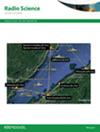Automatic scaling of vertical ionograms based on generative adversarial network
IF 1.5
4区 地球科学
Q3 ASTRONOMY & ASTROPHYSICS
引用次数: 0
Abstract
Ionospheric vertical sounding is a well-established and widely used ground-based technique for ionospheric detection. Efficient and accurate automatic scaling of ionograms is crucial for real-time applications of vertical sounding. However, current scaling methods face challenges in achieving precise trace segmentation due to noise, interference, and various ionospheric disturbances. This paper proposes a deep learning model for ionogram automatic scaling based on generative adversarial network (GAN), which is named IASGAN. The model integrates a 50-layer residual network (ResNet50) and a feature pyramid network (FPN) as the generator, with a multi-layer convolutional neural network (CNN) as the discriminator. Given a vertical ionogram, the generator produces segmentation result that closely resemble the corresponding label, while the discriminator provides feedback loss to the generator for adversarial training, thereby enhancing the segmentation performance of the generator. Experimental results demonstrate that the IASGAN model can precisely and effectively autoscale E, FI, and F2 layer traces. Compared to existing scaling methods, the IASGAN model can produce finer trace extraction from ionograms, with a mean maximum critical frequency absolute deviation (D-MCF) of 0.0803 MHz and a mean minimum virtual height absolute deviation (D-MEH) of 5.8205 km. This capability can provide technical support for the extraction of characteristic parameters and ionospheric inversion, which is significant for real-time acquisition of ionospheric characteristics and structure information.基于生成对抗网络的垂直电离图自动缩放
电离层垂直探测是一种成熟且广泛应用的地面电离层探测技术。高效、准确的电离图自动标度是垂直探测实时应用的关键。然而,由于噪声、干扰和各种电离层干扰,目前的标度方法在实现精确的轨迹分割方面面临挑战。本文提出了一种基于生成式对抗网络(GAN)的离子图自动缩放深度学习模型,称为IASGAN。该模型集成了50层残差网络(ResNet50)和特征金字塔网络(FPN)作为生成器,多层卷积神经网络(CNN)作为鉴别器。给定垂直离子图,发生器产生与对应标签非常相似的分割结果,鉴别器向发生器提供反馈损失进行对抗性训练,从而提高发生器的分割性能。实验结果表明,IASGAN模型可以精确有效地自动缩放E、FI和F2层轨迹。与现有的标度方法相比,IASGAN模型可以从离子图中提取更精细的痕量提取,平均最大临界频率绝对偏差(D-MCF)为0.0803 MHz,平均最小虚拟高度绝对偏差(D-MEH)为5.8205 km。该能力可为特征参数提取和电离层反演提供技术支持,对实时获取电离层特征和结构信息具有重要意义。
本文章由计算机程序翻译,如有差异,请以英文原文为准。
求助全文
约1分钟内获得全文
求助全文
来源期刊

Radio Science
工程技术-地球化学与地球物理
CiteScore
3.30
自引率
12.50%
发文量
112
审稿时长
1 months
期刊介绍:
Radio Science (RDS) publishes original scientific contributions on radio-frequency electromagnetic-propagation and its applications. Contributions covering measurement, modelling, prediction and forecasting techniques pertinent to fields and waves - including antennas, signals and systems, the terrestrial and space environment and radio propagation problems in radio astronomy - are welcome. Contributions may address propagation through, interaction with, and remote sensing of structures, geophysical media, plasmas, and materials, as well as the application of radio frequency electromagnetic techniques to remote sensing of the Earth and other bodies in the solar system.
 求助内容:
求助内容: 应助结果提醒方式:
应助结果提醒方式:


